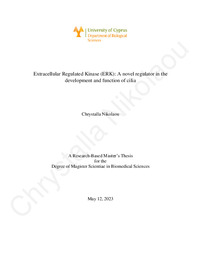| dc.contributor.advisor | Skourides, Paris | en |
| dc.contributor.author | Nikolaou, Chrystalla S. | en |
| dc.coverage.spatial | Cyprus | en |
| dc.creator | Nikolaou, Chrystalla S. | en |
| dc.date.accessioned | 2023-07-05T06:08:33Z | |
| dc.date.available | 2023-07-05T06:08:33Z | |
| dc.date.issued | 2023-06-14 | |
| dc.identifier.uri | http://gnosis.library.ucy.ac.cy/handle/7/65606 | en |
| dc.description.abstract | The role of cilia in biomedicine is becoming more and more recognized since defects in ciliary structure and function induce ciliopathies such as cystic kidney disease, neurological anomalies, obesity, blindness, and skeletal deformities. Here, we examined the possible role of the Extracellular Regulated Kinase 1/2 (ERK1/2) in ciliogenesis and ciliary function. We show that ERK is associated with the basal bodies of primary cilia in cultured cells and in multiciliated cells of Xenopus Laevis raising the possibility that it may have a cilia specific function. Immunofluorescence analysis using known ciliary markers and super resolution microscopy revealed that ERK1/2 is localized at the transition fiber region of cilia. Pharmacological inhibition of ERK phosphorylation using a highly selective drug that inhibits the upstream activator of ERK1/2, MEK1/2, decreases the length and number of primary cilia, suggesting a role in ciliogenesis. In Xenopus multiciliated cells, inhibition of ERK1/2 leads to decreased ciliary flow, suggesting that ERK1/2 has a role in multiciliated cells development and/or function. Analysis of inhibitor treated embryos revealed a multitude of ciliogenesis defects including defective rotational polarity and basal body spacing, disrupted actin network, and reduced apical cell surface. These are consistent with defects elicited by loss of function approaches targeting JNK, suggesting that ERK1/2 may be acting upstream of JNK in the context of ciliogenesis. We go on to show that inhibition of ERK1/2 affects c-junNH2-terminal kinase’s (JNK) activation at the base of the cilia providing evidence for a role of ERK1/2 in the regulation of basal body associated JNK. Overall, the findings of this study reveal a new function of ERK in the development of cilia and their function providing new insights towards our understanding of cilia-related diseases. | en |
| dc.language.iso | eng | en |
| dc.publisher | Πανεπιστήμιο Κύπρου, Σχολή Θετικών και Εφαρμοσμένων Επιστημών / University of Cyprus, Faculty of Pure and Applied Sciences | |
| dc.rights | info:eu-repo/semantics/openAccess | en |
| dc.rights | Open Access | en |
| dc.title | Extracellular Regulated Kinase (ERK): A novel regulator in the development and function of cilia | en |
| dc.type | info:eu-repo/semantics/masterThesis | en |
| dc.contributor.committeemember | Pitsouli Chrysoula | en |
| dc.contributor.committeemember | Georgiades, Pantelis | en |
| dc.contributor.department | Τμήμα Βιολογικών Επιστημών / Department of Biological Sciences | |
| dc.subject.uncontrolledterm | CILIA | en |
| dc.subject.uncontrolledterm | ERK | en |
| dc.subject.uncontrolledterm | CILIOGENESIS | en |
| dc.subject.uncontrolledterm | CILIOPATHIES | en |
| dc.author.faculty | Σχολή Θετικών και Εφαρμοσμένων Επιστημών / Faculty of Pure and Applied Sciences | |
| dc.author.department | Τμήμα Βιολογικών Επιστημών / Department of Biological Sciences | |
| dc.type.uhtype | Master Thesis | en |
| dc.contributor.orcid | Georgiades, Pantelis [0000-0001-6497-3221] | |
| dc.contributor.orcid | Pitsouli, Chrysoula [0000-0003-4074-9684] | |
| dc.contributor.orcid | Skourides, Paris [0000-0003-3502-5729] | |
| dc.gnosis.orcid | 0000-0001-6497-3221 | |
| dc.gnosis.orcid | 0000-0003-4074-9684 | |
| dc.gnosis.orcid | 0000-0003-3502-5729 | |

